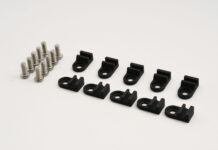By Matt Stone – Photography by the Author & Courtesy of the Ed Iskenderian Collection
Let’s wrap up our look at Isky … the man, the car, and the business in this issue’s closing feature.

“Every time we went out and drove the car or ran it for top speed we learned a lot about what worked and what didn’t–remember we were still teenagers attending the colleges of hard knocks.” Style or styling wasn’t initially important, so he ran the car with no grille, only a radiator mounted up in front of the Flathead V-8, which is what it looked like when he road tripped to Mexico. He finally decided the car needed a face, but didn’t want to go the common routes of either a polished brass model T grille shell or 1932 Ford shell and grille; Isky wanted something totally unique for his car. He recalls, “Back then you could buy nearly any grille shell and insert for $7 to $8.” While trolling a junkyard the nose of a car caught his eye, an early ’30s Pontiac. He liked the shape and detailing of the grille, but didn’t want to run a straight-up Pontiac face on his fabulous little Ford, but his mind’s eye saw the resolution of that problem by combining two top sections of this particular grille, made from two halves from two separate grilles welded together. He bought a pair of the identical Pontiac grilles and shells for $15, cut them each in half horizontally about halfway down, measured, matched, and welded it all together, yielding the unique but appropriate-looking grille and radiator shell the car wears to this day. Which looks great.

The whole look was finished off with red painted Kelsey-Hayes wire wheels, black lacquer paint on the $7 Model T body, and a rugged-looking leather interior stitchjob. Some early magazine reports site the upholstery’s original color as “oxblood maroon,” but sun, time, and age have turned it a warming brown. The rear bolster has long ago torn, and literally and figuratively shows its stuffing. The car ran well with the mildly modified 1936 Flathead and Ed ran it often and hard, including the much-storied trip to Mexico in 1939-1940 just prior to Ed’s military stint, experimenting with cam, exhaust, and intake manifold/carburetor combinations, until ultimately it was “one run too many” and the engine gave way and blew up. The solution was simple enough, as it wasn’t too difficult or expensive to find a Flathead of 1932 vintage in the junkyard, so that’s what he installed. It made sense and matched up to the 1932 three-speed manual transmission he’d been running; this is the engine/trans combo that sits in the car to this day.

For a young guy who wanted to go fast and clearly had his sights on a future somehow in the burgeoning speed parts business, Isky wasn’t likely to be happy with a stock configured Flathead for very long. Being a curious car crazy youth in Southern California he’d come along a company near downtown L.A. that ran and maintained fleets of delivery trucks. Hanging around the yard, asking questions, and sticking his nose under truck hoods he was introduced to aftermarket Maxi brand “F” cylinder heads designed for the Flathead Ford V-8. Conversion to these heads was intended to address two issues, the first being certain Ford V-8 heating problems reputedly because the exhaust valves were mounted in the engine block very close to the cylinders. The second notion was that these aftermarket heads would offer the potential of increased performance for medium to heavy-duty trucking customers. These so-called “F” heads, because they are a partial overhead valve conversion, put only the exhaust valves into the heads to be operated by pushrods and rocker arms yet not relocating both valves into the heads as would be the case in a full overhead valve conversion, as accomplished with such great success by the legendary ARDUN OHV cylinder heads for these engines that came along post World War II.

Another unusual aspect of the Maxi heads is a unique valve cover design. Instead of a single stamped steel or cast-aluminum valve cover that runs down each bank of a V-8 engine covering the valvesprings and rocker arms of four cylinders, the Maxis split the top of the head in two, with two box-shaped valve covers that cover two cylinders each per side. Thus, the engine wears two of these little boxlike covers per cylinder bank. These unusual valve covers resemble small metal bricks.

Isky opined that the newly reconfigured Flathead would require lots more fuel and air than before, so he dreamt up his own intake manifold design, which he fabricated himself, using four small Stromberg carburetors. After testing the car under a variety of conditions, the manifold wasn’t breathing right and wouldn’t go faster than 90, so he reverted to his trusty Edelbrock “slingshot” manifold, which mounted a pair of Stromberg 48 carbs, and the car’s speed picked back up. Over time the car has worn a Navarro intake and a different Edelbrock intake running three carbs; the latter of which is currently on the engine and has been so for decades. All three solutions got the car back up to well over the 100-mph mark. His experimentation with carbs and intakes helped the young rodders learn another lesson about carburetion. Ed recalls one time while driving up to the dry lakes his car was running a little warm, and missing and surging, so he needed to feather the throttle on and off to get it to run cleanly. What he didn’t know is that the engine was running lean, something he never expected with multiple carburetors on his car. He asked around about the problem, and someone asked him if he still had stock jets in his carburetors. He said, “What do you mean, stock jets?” So someone told him that by enlarging the jets a few thousandths of an inch, he could get more fuel into the engine, helping it run cooler and not “starve” as it was doing. Today he notes that “we’d never heard of such a thing; we just thought that the carburetor did its job and if you wanted to go faster, put on a bigger carb or just add more of them! So, we drilled out the carb jets about five thousandths of an inch, and the car ran perfect and got faster at the same time.” Result!

Literally and figuratively the engine’s capper is a set of custom-made aluminum valve covers bearing the owner’s last name, Iskenderian, in an elegant cursive script. Isky credits pal Athan as a “gifted artist and draftsman” so he designed and laid out the script for these one-off, personalized covers, which he then hand-carved into the metal. Cast in raw aluminum, they’ll polish to a bright sheen but tarnish to a soft glow easily as the metal is uncoated or plated. In as much as the configuration of these valve covers wasn’t the same as the “double-box style” valve covers the Maxi heads would normally use, Ed fabricated a metal baseplate in order to seal up the bottom of the covers and ensure they sealed tight to the heads. No matter, these one-of-a-kind valve covers are beautiful pieces of casting artwork, making the car and engine utterly unique to its owner/builder. The job was further finished off by a long, flowing, chromed dual exhaust system visible from any angle of the car.

By now you may be wondering what sort of camshaft this car has run for all these decades. Funny enough, it is this car and the backstory of its cam that further opened the door to Isky entering the cam grinding business as a profession. For a time, he ran a camshaft produced by his friend and mentor, the great Ed Winfield, but later changed it to one of his very earliest Isky Racing Cams designs. And it all worked, too.

The car’s construction and ultimate finish took place over a somewhat protracted amount of time, as he bought the car from Athan in the late ’30s then got it running with the stock Flathead V-8 prior to his trip to Mexico. Then along came World War II, and his military service, calling a halt to the build for several years. The final black lacquer repaint and interior work came after the end of the war, so by the late ’40s the Isky roadster was looking good and standing tall, ready for an upcoming cameo on the cover of Hot Rod.

He’d previously cranked the car up to a 111-mph top speed at Muroc, then on May 5, 1942, at a Western Timing Association meet at El Mirage, he topped out at a more than respectable 120 mph; this event is recognized by an engraved timing plate affixed to the dashboard then and now.

So highly regarded was this fast and handsome rod that it was declared “Hot Rod of the Month” by the young Hot Rod magazine. Isky’s T was featured on the cover of Hot Rod’s June ’48 issue, and honored with a one-page “feature” on page 7 of that same magazine; it’s amusing that the article’s story about the how and what of the car’s build differs slightly from Ed’s version.
By the mid ’50s he had a growing business and family, so the roadster was somewhat pushed to the back of his thoughts and literally pushed to the back of the shop where it gathered more than a bit of dust and myriad of nicks, scrapes, and quick and dirty paint touchups along the way. He no longer drove it every day, occasionally firing it up for a quick ride to lunch or with a friend, customer, or automotive writer in the passenger side of the seat. It was last licensed for road use in 1951 and one can only guess when its last oil change was, although it’s been recently serviced and fires and runs on the button.

One particularly interesting bit of jewelry that the car wears is its unique skull-faced radiator mascot. It’s obviously hand cast and comes with a backstory all its own. The look was inspired by the radiator mascot on another of Isky and Athan’s friend’s car, the young man (whose name Ed doesn’t recall), a handsome, very “together” guy a few years older than them, and someone the younger group of guys looked up to; he may not have returned from frontline duty during World War II. Isky always liked the look of his car, particularly of this aluminum casting, and bought the original piece off his friend’s car for $2.

It’s a little amazing that Ed Iskenderian has owned this humble little T-bucket roadster for some 80 years now. Its 70-some-odd-year-old black lacquer paint is scarred and scuffed; what little chrome that’s on the car has begun to bloom and tarnish. The interior leather is faded, hard, and torn in places. The old 16-inch-wide whitewalls are as dry and hard as concrete, down to cord in some places, virtually bereft of tread, and the sidewalls have shredded and yellowed from hard use and age. A couple might hold air.

Packing more charisma than a Cary Grant lookalikes convention, and more patina than the Titanic, the Isky rod is a testimony to the young hot rodder who built and raced it, and it survives with all of its many wonderful stories and inside jokes intact. Ed recalls it costing him about $1,000 (not including his own time and labor) to build, and its value now is incalculable—to tear apart and redo or restore this car would be a crime of the first order. It’s otherwise perfect, honest, real, and historic. It’s charming and positively glows of hot rod history.
Early hot rodding’s Holy Grail? Among them for sure. MR

































